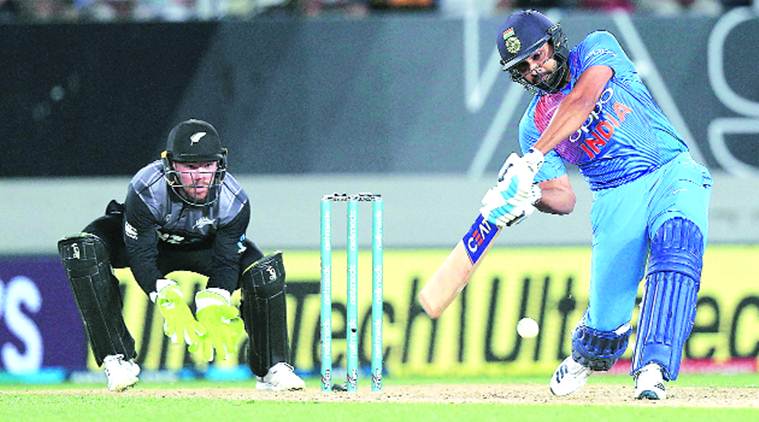
In the end, it was an open-and-shut case. A 159-run target was never going to test India’s heavy-duty top-order. Some effervescent stroke-play from captain Rohit Sharma and Rishabh Pant, backed by Eden Park’s infamously short boundary line, played a part in their commanding chase. Just two days after being consigned to their worst-ever defeat — in terms of the number of runs in T20s — the visitors romped home to an emphatic seven-wicket win.
This result locked the three-match series at 1-1, leaving India with a tantalizing prospect of ending a memorable three-month sojourn in the southern hemisphere without a series loss. The chase was fundamentally built upon the rock-solid platform built by the opening combo of Sharma and Shikhar Dhawan.
The Indian captain was the aggressor, setting the tone with his effortless, clean hitting upfront. He took a special liking to Auckland’s rectangular-shaped multi-purpose facility, creaming four sixes enroute his 30-ball 50. In the process, he went past Martin Guptill’s tally of 2,272 runs to become the highest scorer in T20s.
The 79-run opening alliance in 9.2 overs gave the likes of Rishabh Pant and MS Dhoni the license to adopt an uninhibited and clutter-free approach. The ongoing series is seen as an audition to the big-ticket World Cup in England, scheduled to begin on May 30. Rishabh Pant, on his part, did his reputation no harm whatsoever with his whirlwind knock. His unbeaten 40 was laced with his usual pyrotechnics and brute force. However, what would please him is the fact that he stayed unbeaten till the end with the experienced Dhoni. Quite often in the past, the 21-year-old has shown the tendency to fritter away starts and not finishing off matches. This was precisely the reason for his intermittent appearances in the shorter formats at the international level.
Khaleel in his element
Even as India’s batting basked under Auckland’s evening glow, it was the clinical display from their bowlers who had orchestrated a commendable job to restrict the Kiwis to a below-par total of 158/8. Leading the attack was Khaleel Ahmed, the 21-year-old left-arm seamer from Rajasthan, who whipped up a decent pace, even as he hit a disconcerting length that choked the usually rampant New Zealand’s openers Tim Seifert and Colin Munro. Coming into this match, the youngster was served with a stern warning from his captain who said: “The boundaries are really short here, take care off your length.”
Bowling in a T20 match at Eden Park can be quite a harrowing experience first-up for any bowler. Just to put things into perspective, the straight boundary at this venue is just 55m, which is really short when you take into account the dimensions at some of the bigger venues in Australia like the Melbourne Cricket Ground, which is 83m from one end of the wicket to the straight fence. The Sydney Cricket Ground, on the other hand, is the longest at a whopping 94m. Surprisingly, Khaleel displayed remarkable poise in altering his length, taking utmost care not to drop it too short. He began his spell with four dot balls to Seifert, all off which were predominantly much more fuller, all slanting across the batsman at decent pace.
While Khaleel was pin-point in his execution of plans, it restricted the run-flow to a fair degree, allowing his opening partner Bhuvneshwar Kumar and first-change bowler Hardik Pandya to settle into a fairly good rhythm. Kumar eventually scythed through Seifert, while Pandya removed the dangerous Colin de Grandhomme. Khaleel returned at the fag end to remove Mitchell Santner and Tim Southee, to finish with impressive figures of 2/27 from four overs. After some stirring performances against West Indies in November last year, Khaleel had looked like he had gone off the boil in the T20 and ODI series in Australia that preceded this tour, where he was erratic in his lines and lengths, as a consequence of which he went for plenty.
He made amends tonight, underlining his potential and reaffirming why the team management is cock-a-hoop to have him in the shorter formats.
The sustained pressure exerted by India’s three-pronged pace attack was a heartening sight. More so, after the manner in which they were put to the sword in Wellington, where they had collectively bled 146 runs, their worst-ever performance in a T20 fixture. On Friday evening, the trio was much more parsimonious, conceding 92 runs in their 12 overs and etching out some telling blows in the process. Collectively, they could not have stepped up at a more opportune moment, especially with India going into this game without their two best fast bowlers in Jasprit Bumrah and Mohammad Shami. Sharma was quick to heap praise on his young pace attack.
“I was very pleased with the way we bowled to start with and then it was very clinical with the bat as well….something like that we were expecting. We’ve got quality in our side. It’s just that we didn’t execute our plans in the first game and we learned from our mistakes. We executed those plans in this game and we got the reward for it,” he quipped.